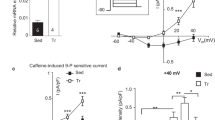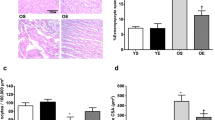Abstract
Ageing is characterized by decline in physical endurance which has been suggested to be partly due to diminished functional and adaptive reserve capacity of the heart. Ageing is associated with decrease in numbers of sarcolemmal ATP-sensitive K+ (KATP) channels, but whether this has anything to do with ageing-induced decline in physical endurance is yet to be determined. We have previously shown that the numbers of sarcolemmal KATP channels are controlled by the level of expression of SUR2A, a KATP channel regulatory subunit. Here, we have found that ageing decreases the level of SUR2A mRNA in the heart without affecting expression of pore-forming KATP channel subunits, Kir6.1 and Kir6.2. This effect of ageing was associated with decrease in levels of fully-assembled sarcolemmal KATP channels. At the same time, ageing was associated with decreased physical endurance. In order to determine whether increased expression of SUR2A would counteract ageing-induced decrease in physical endurance, we have taken advantage of mice which SUR2A levels are regulated by more efficient CMV promoter. These mice had increased resistance of cardiomyocytes to metabolic stress/hypoxia and increased physical endurance when compared to the wild type. In transgenic mice, ageing did not affect the level of SUR2A mRNA in the heart and the level of fully-assembled sarcolemmal KATP channels. The effect of increased SUR2A to resistance of cardiomyocytes to hypoxia and physical endurance was retained in old mice. The magnitude of these effects was such that they were significantly increased even when compared to those in wild type young mice. We conclude that (1) the level of SUR2A expression in the heart is important factor in regulating physical endurance, (2) ageing-induced decrease in cardiac SUR2A is, at least in part, responsible for ageing-induced decline in physical fitness and (3) up-regulation of SUR2A could be a viable strategy to counteract ageing-induced decline in physical endurance.



Similar content being viewed by others
References
Bogan KL, Brenner C (2008) Nicotinic acid, nicotinamide, and nicotinamide riboside: a molecular evaluation of NAD+ precursor vitamins in human nutrition. Annu Rev Nutr 28:115–130
Brown DA, Moore RL (2007) Perspectives in innate and acquired cardioprotection: cardioprotection acquired through exercise. J Appl Physiol 103:1894–1899
Budas GR, Jovanović S, Crawford RM, Jovanović A (2004) Hypoxia-induced preconditioning in adult stimulated cardiomyocytes is mediated by the opening and trafficking of sarcolemmal KATP channels. FASEB J 18:1046–1048
Budas GR, Sukhodub A, Alessi DR, Jovanović A (2006) 3′Phosphoinositide-dependent kinase-1 (PDK1) is essential for ischaemic preconditioning of the myocardium. FASEB J 20:2556–2558
Crawford RM, Jovanović S, Budas GR, Davies AM, Lad H, Wenger RH, Robertson KA, Roy DJ, Ranki HJ, Jovanović A (2003) Chronic mild hypoxia protects heart-derived H9c2 cells against acute hypoxia/reoxygenation by regulating expression of the SUR2A subunit of the ATP-sensitive K+ channels. J Biol Chem 278:31444–31455
Du Q, Jovanović S, Clelland A, Sukhodub A, Budas GR, Phelan K, Murray-Tait V, Malone L, J Jovanović A (2006) Overexpression of SUR2A generates a cardiac phenotype resistant to ischaemia. FASEB J 20:1131–1141
Du Q, Jovanović S, Sukhodub A, Jovanović A (2010) Infection with AV-SUR2A protects H9C2 cells against metabolic stress: a mechanism of SUR2A-mediated cytoprotection independent from the KATP channels activity. Biochem Biophys Acta Mol Cell Res 1803:405–415
Faghihi M, Sukhodub A, Jovanović S, Jovanović A (2008) Mg2+ protects adult beating cardiomyocytes against ischaemia. Int J Mol Med 21:69–73
Frankel JE, Bean JF, Frontera WR (2006) Exercise in the elderly: research and clinical practice. Clin Geriatr Med 22:239–256
Granfeldt A, Lefer DJ, Vinten-Johansen J (2009) Protective ischaemia in patients: preconditioning and postconditioning. Cardiovasc Res 83:234–246
Ingwall JS, Weiss RG (2004) Is the failing heart energy starved? On using chemical energy to support cardiac function. Circ Res 95:135–145
Jovanović A (2006) Ageing, gender and cardiac sarcolemmal KATP channels. J Pharmac Pharmacol 58:1585–1589
Jovanović S, Jovanović A (2004) Sarcolemmal KATP channels in ageing. Ageing Res Rev 3:199–214
Jovanović A, Jovanović S (2009) SUR2A targeting for cardioprotection? Curr Opin Pharmacol 9:189–193
Jovanović A, Jovanović S, Lorenz E, Terzic A (1998) Recombinant cardiac ATP-sensitive K+ channel subunits confer resistance towards chemical hypoxia-reoxygenation injury. Circulation 98:1548–1555
Jovanović S, Du Q, Mukhopadhyay S, Swingler R, Buckley R, McEachan J, Jovanović A (2008) A patient suffering from hypokalemic periodic paralysis is deficient in skeletal muscle ATP-sensitive K+ channels. Clin Transl Sci 1:71–74
Jovanović S, Du Q, Sukhodub A, Jovanović A (2009a) M-LDH physically associated with sarcolemmal KATP channels mediates cytoprotection in heart embryonic H9C2 cells. Int J Biochem Cell Biol 41:2295–2301
Jovanović S, Du Q, Sukhodub A, Jovanović A (2009b) Dual mechanism of cytoprotection afforded by M-LDH in embryonic heart H9C2 cells. Biochem Biophys Acta Mol Cell Res 1793:1379–1386
Kane GC, Liu XK, Yamada S, Olson TM, Terzic A (2005) Cardiac KATP channels in health and disease. J Mol Cell Cardiol 38:937–943
Noma A (1983) ATP-regulated K+ channels in cardiac muscle. Nature 305:147–148
Ogawa T, Spina RJ, Martin WH, Kohrt WV, Schechtman KB, Holloszy JO, Ehsani AA (1992) Effects of aging, sex, and physical training on cardiovascular responses to exercise. Circulation 86:494–503
Ranki HJ, Budas GR, Crawford RM, Jovanović A (2001) Gender-specific difference in cardiac ATP-sensitive K+ channels. J Am Coll Cardiol 38:906–915
Ranki HJ, Crawford RM, Budas GR, Jovanović A (2002a) Ageing is associated with decrease in number of sarcolemmal ATP-sensitive K+ channels in a gender-dependent manner. Mech Ageing Dev 123:695–705
Ranki HJ, Budas GR, Crawford RM, Davies AM, Jovanović A (2002b) 17β-estradiol regulates expression of KATP channels in heart-derived H9c2 cells. J Am Coll Cardiol 40:367–374
Sukhodub A, Jovanović S, Du Q, Budas GR, Clelland A, Shen M, Sakamoto K, Tian R, Jovanović A (2007) AMP-activated protein kinase mediates preconditioning in cardiomyocytes by regulating activity and trafficking of sarcolemmal ATP-sensitive K+ channels. J Cell Physiol 210:224–236
Sukhodub A, Sudhir R, Du Q, Jovanović S, Reyes S, Jovanović A (2010a) Nicotinamide-rich diet improves physical endurance by upregulating SUR2A in the heart. J Cell Mol Med. doi:10.1111/j.1582-4934.2010.01156.x
Sukhodub A, Du Q, Jovanović S, Jovanović A (2010b) Nicotinamide-rich diet protects the heart against ischaemia-reperfusion in mice: a crucial role for cardiac SUR2A. Pharmacol Res 61:564–570
Wiebe CG, Gledhill N, Jamnik VK, Ferguson S (1999) Exercise cardiac function in young through elderly endurance trained women. Med Sci Sports Exerc 31:684–691
Zingman LV, Hodgson DM, Bast PH, Kane GC, Perez-Terzic C, Gumina RJ, Pucar D, Bienengraeber M, Dzeja PP, Miki T, Seino S, Alekseev AE, Terzic A (2002) Kir6.2 is required for adaptation to stress. Proc Natl Acad Sci USA 99:13278–13283
Zingman LV, Alekseev AE, Hodgson-Zingman D, Terzic A (2007) ATP-sensitive K+ channels: metabolic sensing and cardioprotection. J Appl Physiol 103:1888–1893
Acknowledgments
This research was supported by grants from the British Heart Foundation, Biotechnology and Biological Sciences Research Council, Medical Research Council, TENOVUS-Scotland, Wellcome Trust and Anonymous Trust.
Author information
Authors and Affiliations
Corresponding author
Rights and permissions
About this article
Cite this article
Sudhir, R., Sukhodub, A., Du, Q. et al. Ageing-induced decline in physical endurance in mice is associated with decrease in cardiac SUR2A and increase in cardiac susceptibility to metabolic stress: therapeutic prospects for up-regulation of SUR2A. Biogerontology 12, 147–155 (2011). https://doi.org/10.1007/s10522-010-9306-3
Received:
Accepted:
Published:
Issue Date:
DOI: https://doi.org/10.1007/s10522-010-9306-3




